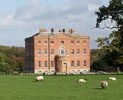COUNTRY LIFE Manifesto: End VAT on repairs
Country Life calls on the Government to end VAT on repairs to historic buildings


Think of Britain. Is the first image that comes to mind a shiny modern building or a thatched cottage? Probably the latter. Consider climate change: is it more energy-efficient to recycle old buildings or to build new ones? Definitely the former. What sort of built environment do we want to live in? One which encourages the construction of new buildings, sprawling out of towns onto greenfield land, or one which puts the conservation of existing structures on the same footing as new build? The latter, surely. And yet we live in a world which encourages new build, which is zero rated for VAT, at the expense of restoration, which is charged at 17.5%. Country Life believes that the general public would much rather the position was reversed, or at least equalised. That is why we made the abolition of VAT on repairs one of the demands of our Countryside Manifesto.
Owners of historic properties are all too pleased to occupy part of the heritage. Most of them cherish the buildings in their care, and feel privileged to do so. But as everyone knows, maintaining old structures is an expensive business. It is only when you take down a water-damaged ceiling that you find dry rot. Often, repair work requires specialist skills. To its credit, the Government has already accepted that church congregations should have the VAT on the repair of parish churches refunded to them. Certainly parish churches are one of the glories of this country, but so are our old houses and other historic buildings. It could be argued that, in the case of a church, the burden falls on a group of people (albeit, in the case of many rural congregations, a small and ageing one). Houses are usually the responsibility of a single, hard-pressed individual. Why should he be treated differently?
Naturally, the planning system requires that the highest standards are applied to listed buildings. But the amount of money made available by the Government to private owners does not match these expectations. According to the Historic Houses Association, English Heritage has seen its grant for privately owned historic buildings fall by £24 million in real terms between 2000 and 2008. This year, it will help them to the tune of a measly £2 million. We know the reason. Old buildings have never been viewed warmly by New Labour, which is by instinct drawn towards trendy Modernism; it has shown a consistent animus towards history. Now there is additional pressure from the 2012 Olympics, which is running massively over budget.
The Treasury should address this manifest unfairness. Historic houses that open their doors to visitors provide an obvious benefit to the public. Moreover, it is in the national interest that all listed buildings should be kept in sound condition. That is why they were listed in the first place. We also need to create opportunities for young people to work as carpenters, stonemasons, bricklayers and plumbers. This will widen the skill-base in the building industry, and create worthwhile jobs for people who are not suited to desk work. The repair of historic buildings provides the best training that a young craftsman could hope to get.
There is a backlog of repairs to historic buildings in this country. Removing VAT on them would encourage more private money to be spent. The amount of tax revenue that the Treasury would have to refund to private owners, if it adopted the churches model, would be modest ?about £14 million. Recently, other European countries were quick to take advantage of a European provision which allowed governments to set a lower rate of VAT for labour-intensive activities that would encourage job creation. France saw it as an opportunity to help owners of the patrimoine. The Treasury failed to register for the scheme before the window to do so closed in March. Shame on you, Mr Brown.
Sign up for the Country Life Newsletter
Exquisite houses, the beauty of Nature, and how to get the most from your life, straight to your inbox.
Country Life is unlike any other magazine: the only glossy weekly on the newsstand and the only magazine that has been guest-edited by HRH The King not once, but twice. It is a celebration of modern rural life and all its diverse joys and pleasures — that was first published in Queen Victoria's Diamond Jubilee year. Our eclectic mixture of witty and informative content — from the most up-to-date property news and commentary and a coveted glimpse inside some of the UK's best houses and gardens, to gardening, the arts and interior design, written by experts in their field — still cannot be found in print or online, anywhere else.
-
 Six rural properties with space, charm and endless views, as seen in Country Life
Six rural properties with space, charm and endless views, as seen in Country LifeWe take a look at some of the best houses to come to the market via Country Life in the past week.
By Toby Keel
-
 Exploring the countryside is essential for our wellbeing, but Right to Roam is going backwards
Exploring the countryside is essential for our wellbeing, but Right to Roam is going backwardsCampaigners in England often point to Scotland as an example of how brilliantly Right to Roam works, but it's not all it's cracked up to be, says Patrick Galbraith.
By Patrick Galbraith